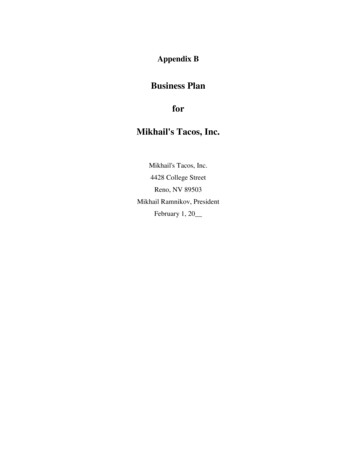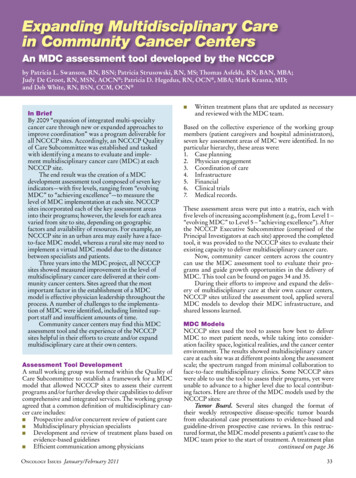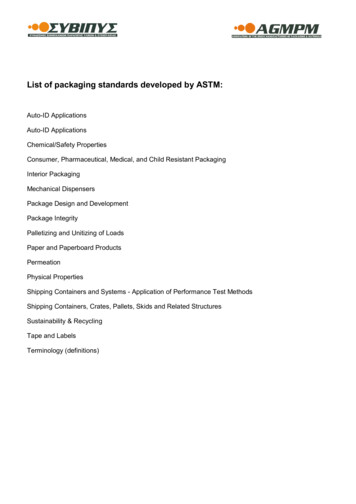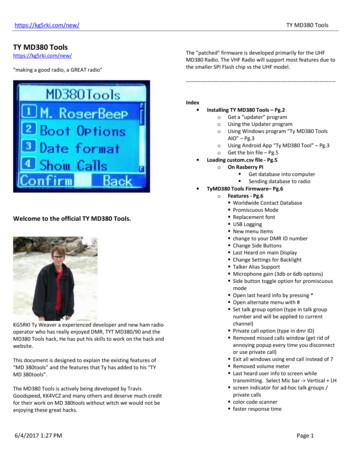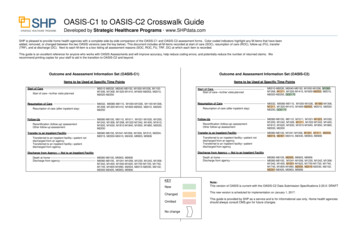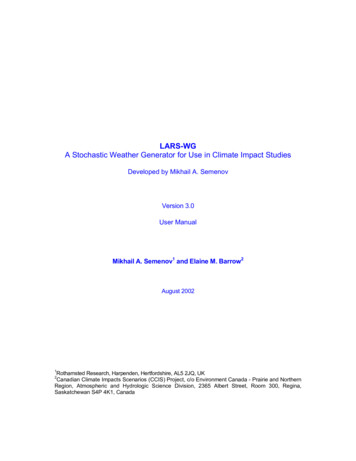
Transcription
LARS-WGA Stochastic Weather Generator for Use in Climate Impact StudiesDeveloped by Mikhail A. SemenovVersion 3.0User ManualMikhail A. Semenov1 and Elaine M. Barrow2August 20021Rothamsted Research, Harpenden, Hertfordshire, AL5 2JQ, UKCanadian Climate Impacts Scenarios (CCIS) Project, c/o Environment Canada - Prairie and NorthernRegion, Atmospheric and Hydrologic Science Division, 2365 Albert Street, Room 300, Regina,Saskatchewan S4P 4K1, Canada2
LARS-WG: Stochastic Weather Generator1Contents0:TECHNICAL INFORMATION FOR USING LARS-WG .20.1:Set-up and starting LARS-WG.21:INTRODUCTION .32:MODEL DESCRIPTION.42.1:3:Outline of the stochastic weather generation process .5KEY FUNCTIONS OF THE SOFTWARE.53.1:Site Analysis anation of the *.tst file . 13Creating climate scenarios from GCM output. 20Spatial interpolation of LARS-WG .264:REFERENCES.265:ADDRESS FOR COMMUNICATIONS .276:LICENCE AGREEMENT.27
LARS-WG: Stochastic Weather Generator0:2TECHNICAL INFORMATION FOR USING LARS-WGLARS-WG can be downloaded from . Pleaseregister to use LARS-WG by providing your name, affiliation and address in the appropriate places onthe web form. By registering to use LARS-WG, you will receive information about any updates toLARS-WG.LARS-WG is protected by a licence agreement. It may be used free of charge, with dueacknowledgement to the model’s developer, for academic research purposes. For use within a researchproject, a licence is required. LARS-WG cannot be used for any commercial purposes.LARS-WG Version 3.0 is implemented in C with a full Windows interface. It can be run on aPC with Windows 9x/NT/2000/XP. There are no special requirements for memory size or disk space(note that 100 years of generated data takes 1.5Mb of disk space). LARS-WG requires littleprocessing time for most situations.0.1: Set-up and starting LARS-WGOnce you have downloaded the larswg.exe file into the directory of your choice, simply double-clickon the larswg.exe file to activate the set-up process. Fill in the details of the directory to which you wishto unpack the set-up files when prompted. Double-click on the setup.exe file in this directory to installLARS-WG onto your PC. Follow the prompts for successful installation of LARS-WG. Unless youspecify otherwise, LARS-WG will be installed into the c:\Program Files\LARS-WG 3.0 directory, whichwill be created during the set-up process. The directions given in this user manual assume that the defaultsettings have been used.Once LARS-WG has been installed, the model is started by double-clicking on the larswg.exe file(denoted by the butterfly icon) located in the c:\Program Files\LARS-WG 3.0 directory. To simplifythis process, a shortcut to this file can be created. Simply right-click with the mouse on the larswg.exefile and select the ‘Create Shortcut’ option. A shortcut to this file will appear in this directory and canbe moved to the desktop by selecting and dragging the file with the mouse. After this has been done,LARS-WG can be started by double-clicking on the butterfly icon on the desktop.
LARS-WG: Stochastic Weather Generator1:3INTRODUCTIONLARS-WG is a stochastic weather generator which can be used for the simulation of weather data ata single site (Racsko et al, 1991; Semenov et al, 1998; Semenov & Brooks, 1999), under both current andfuture climate conditions. These data are in the form of daily time-series for a suite of climate variables,namely, precipitation (mm), maximum and minimum temperature ( C) and solar radiation (MJm-2day-1).Stochastic weather generators were originally developed for two main purposes:1. To provide a means of simulating synthetic weather time-series with statistical characteristicscorresponding to the observed statistics at a site, but which were long enough to be used in anassessment of risk in hydrological or agricultural applications.2. To provide a means of extending the simulation of weather time-series to unobserved locations,through the interpolation of the weather generator parameters obtained from running the models atneighbouring sites.It is worth noting that a stochastic weather generator is not a predictive tool that can be used inweather forecasting, but is simply a means of generating time-series of synthetic weather statistically‘identical’ to the observations.New interest in local stochastic weather simulation has arisen as a result of climate change studies. Atpresent, output from global climate models (GCMs) is of insufficient spatial and temporal resolution andreliability to be used directly in impact models. A stochastic weather generator, however, can serve as acomputationally inexpensive tool to produce multiple-year climate change scenarios at the daily timescale which incorporate changes in both mean climate and in climate variability (Semenov & Barrow,1997).The first version of the LARS-WG weather generator was developed in Budapest in 1990 as part ofAssessment of Agricultural Risk in Hungary, a project funded by the Hungarian Academy of Sciences(Racsko et al, 1991). The main focus of this work was to overcome the limitations of the Markov chainmodel of precipitation occurrence (Bailey, 1964; Richardson, 1981). This widely used method ofmodelling precipitation occurrence (which generally considers two precipitation states, wet or dry,and considers conditions on the previous day only) is not always able to correctly simulate themaximum dry spell length, which is crucial for a realistic assessment of agricultural production insome regions of the world, Hungary included. This resulted in the new ‘series’ approach, in which thesimulation of dry and wet spell length is the first step in the weather generation process.A modified version of this weather generator, now called LARS-WG (Long Ashton Research StationWeather Generator - the location at which it was developed in its current form), was used in theconstruction of the climate change scenarios used in two major European Union-funded research projectsexamining the impacts of climate change on agricultural potential in Europe, i.e., CLAIRE (Harrison etal., 1995) and CLIVARA (Downing et al., 2000). Further details of these high resolution climate changescenarios may be found in Semenov and Barrow (1997).The most recent version of LARS-WG (version 3.0 for Windows 9x/NT/2000/XP) has undergone acomplete redevelopment in order to produce a robust model capable of generating synthetic weather datafor a wide range of climates. LARS-WG has been compared with another widely-used stochastic weathergenerator, which uses the Markov chain approach (WGEN; Richardson, 1981; Richardson and Wright,1984), at a number of sites representing diverse climates and has been shown to perform at least as wellas, if not better than, WGEN at each of these sites (Semenov et al, 1998).
LARS-WG: Stochastic Weather Generator2:4MODEL DESCRIPTIONLARS-WG is based on the series weather generator described in Racsko et al. (1991). It utilisessemi-empirical distributions for the lengths of wet and dry day series, daily precipitation and dailysolar radiation. The semi-empirical distribution Emp { a0, ai; hi, i 1,. ,10} is a histogram with tenintervals, [ai-1, ai), where ai-1 ai, and hi denotes the number of events from the observed data in thei-th interval. Random values from the semi-empirical distributions are chosen by first selecting one ofthe intervals (using the proportion of events in each interval as the selection probability), and thenselecting a value within that interval from the uniform distribution. Such a distribution is flexible andcan approximate a wide variety of shapes by adjusting the intervals [ai-1, ai). The cost of thisflexibility, however, is that the distribution requires 21 parameters (11 values denoting the intervalbounds and 10 values indicating the number of events within each interval) to be specified comparedwith, for example, 3 parameters for the mixed-exponential distribution used in an earlier version ofthe model to define the dry and wet day series (Racsko et al., 1991).The intervals [ai-1, ai) are chosen based on the expected properties of the weather variables. Forsolar radiation, the intervals [ai-1, ai) are equally spaced between the minimum and maximum valuesof the observed data for the month, whereas for the lengths of dry and wet series and for precipitation,the interval size gradually increases as i increases. In the latter two cases, there are typically manysmall values but also a few very large ones and this choice of interval structure prevents a very coarseresolution being used for the small values.The simulation of precipitation occurrence is modelled as alternate wet and dry series, where awet day is defined to be a day with precipitation 0.0 mm. The length of each series is chosenrandomly from the wet or dry semi-empirical distribution for the month in which the series starts. Indetermining the distributions, observed series are also allocated to the month in which they start. For awet day, the precipitation value is generated from the semi-empirical precipitation distribution for theparticular month independent of the length of the wet series or the amount of precipitation on previousdays.Daily minimum and maximum temperatures are considered as stochastic processes with daily meansand daily standard deviations conditioned on the wet or dry status of the day. The technique used tosimulate the process is very similar to that presented in Racsko et al. (1991). The seasonal cycles ofmeans and standard deviations are modelled by finite Fourier series of order 3 and the residuals areapproximated by a normal distribution. The Fourier series for the mean is fitted to the observed meanvalues for each month. Before fitting the standard deviation Fourier series, the observed standarddeviations for each month are adjusted to give an estimated average daily standard deviation by removingthe estimated effect of the changes in the mean within the month. The adjustment is calculated using thefitted Fourier series already obtained for the mean.The observed residuals, obtained by removing the fitted mean value from the observed data, are usedto analyse a time autocorrelation for minimum and maximum temperatures. For simplicity both of theseare assumed to be constant through the whole year for both dry and wet days with the average value fromthe observed data being used. Minimum and maximum temperature residuals have a pre-set crosscorrelation of 0.6. Occasionally, simulated minimum temperature is greater than simulated maximumtemperature, in which case the program replaces the minimum temperature by the maximum less 0.1.The analysis of daily solar radiation over many locations showed that the normal distribution fordaily solar radiation, commonly used in other weather generators, is unsuitable for certain climates (Chiaand Hutchinson, 1991). The distribution of solar radiation also varies significantly on wet and dry days.Therefore, separate semi-empirical distributions were used to describe solar radiation on wet and drydays. An autocorrelation coefficient was also calculated for solar radiation and assumed to be constantthroughout the year. Solar radiation is modelled independently of temperature. LARS-WG acceptssunshine hours as an alternative to solar radiation data. If solar radiation data are unavailable, then
LARS-WG: Stochastic Weather Generator5sunshine hours may be used; these are automatically converted to solar radiation using the approachdescribed in Rietveld (1978).2.1: Outline of the stochastic weather generation processThe process of generating synthetic weather data can be divided into three distinct steps:1. Model Calibration - SITE ANALYSIS - observed weather data are analysed to determine theirstatistical characteristics. This information is stored in two parameter files.2. Model Validation - QTEST - the statistical characteristics of the observed and synthetic weatherdata are analysed to determine if there are any statistically-significant differences.3. Generation of Synthetic Weather Data - GENERATOR - the parameter files derived fromobserved weather data during the model calibration process are used to generate synthetic weatherdata having the same statistical characteristics as the original observed data, but differing on aday-to-day basis. Synthetic data corresponding to a particular climate change scenario may alsobe generated by applying global climate model-derived changes in precipitation, temperature andsolar radiation to the LARS-WG parameter files.The operation of LARS-WG is now described in detail.3:KEY FUNCTIONS OF THE SOFTWAREDouble-click on the larswg.exe file (denoted by the butterfly icon) located in the c:\ProgramFiles\LARS-WG 3.0 directory, or on th
PC with Windows 9x/NT/2000/XP. There are no special requirements for memory size or disk space (note that 100 years of generated data takes 1.5Mb of disk space). LARS-WG requires little processing time for most situations. 0.1: Set-up and starting LARS-WG
